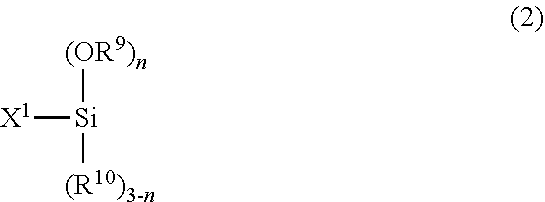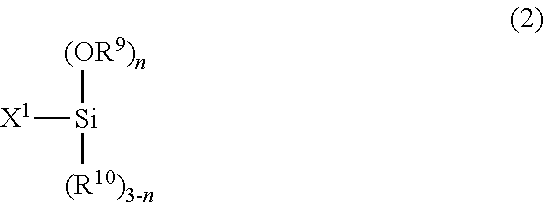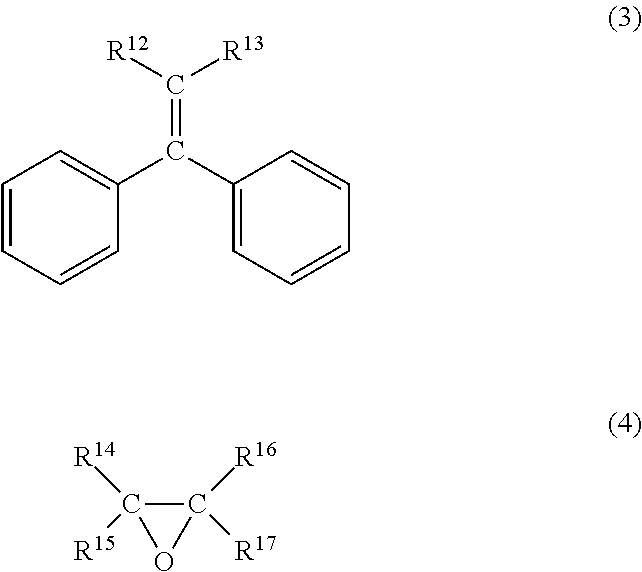Method of production of modified conjugated diene rubber
- Summary
- Abstract
- Description
- Claims
- Application Information
AI Technical Summary
Benefits of technology
Problems solved by technology
Method used
Image
Examples
production example 1
rization Initiator 1 (Lithiation of 1,3,5-Trimethylbenzene)
[0140]Under a nitrogen atmosphere, a glass reaction vessel was charged with 16 parts of cyclohexane, 0.841 part of 1,3,5-trimethylbenzene, and 0.813 part of tetramethylethylenediamine. Next, 1.345 parts of n-butyllithium (in an amount giving 0.3 mole of tetramethylethylenediamine with respect to 1 mole of n-butyllithium) was added thereto under stirring, and the resultant was allowed to stand still for a reaction at a reaction temperature of 60° C. for 2 days, and thus, 18.999 parts of a solution of a polymerization initiator 1 (that is, lithiated 1,3,5-trimethylbenzene) was obtained. Next, for the purpose of measuring a lithiation rate of the lithiated 1,3,5-trimethylbenzene thus obtained by the reaction, several drops of the obtained reaction solution were added to a glass container to which an excessive amount of trimethylsilyl chloride had been added, and the resultant was allowed to react for 30 minutes. Tap water was u...
example 1
[0148][Production of Modified Styrene-butadiene Rubber 1]
[0149]Under a nitrogen atmosphere, an autoclave was charged with 800 parts of cyclohexane, 94.8 parts of 1,3-butadiene, 25.2 parts of styrene, and 0.185 part of tetramethylethylenediamine, and then 0.812 part of a solution of the polymerization initiator 1 (lithiated 1,3,5-trimethylbenzene) obtained in Production Example 1 was added thereto (an amount of tetramethylethylenediamine present in the reaction system was 2.0 moles with respect to 1 mole of n-butyllithium used in the lithiation of 1,3,5-trimethylbenzene), and polymerization was started at 60° C. The polymerization reaction was continued for 60 minutes, and after confirming that a polymerization conversion rate reached a range of 95% to 100%, 0.051 part of propylene oxide (an activity control agent) was added thereto, followed by performing a reaction for 15 minutes. Besides, 0.306 part of chloromethyltriisopropoxysilane (a modifier) was added thereto, followed by per...
example 2
[0154][Production of Modified Styrene-butadiene Rubber 2]
[0155]A modified styrene-butadiene rubber 2 was produced in the same manner as in Example 1 except that 0.200 part of chloromethylisopropoxydimethylsilane was used as a modifier instead of 0.306 part of chloromethyltriisopropoxysilane. The thus obtained modified styrene-butadiene rubber 2 was subjected to the GPC measurement, and was found to contain an eluted component (having a peak area ratio of 14.4%) with Mn of 151,000, Mw of 192,000 and a molecular weight distribution (Mw / Mn) of 1.27, an eluted component (having a peak area ratio of 17.3%) with Mn of 361,000, Mw of 374,000 and a molecular weight distribution (Mw / Mn) of 1.03, and an eluted component (having a peak area ratio of 68.3%) with Mn of 742,000, Mw of 753,000 and a molecular weight distribution (Mw / Mn) of 1.01, and was found to have Mn of 444,000, Mw of 641,000 and a molecular weight distribution (Mw / Mn) of 1.44 as a whole. Besides, the rubber was subjected to th...
PUM
| Property | Measurement | Unit |
|---|---|---|
| Percent by mass | aaaaa | aaaaa |
| Percent by mass | aaaaa | aaaaa |
| Fraction | aaaaa | aaaaa |
Abstract
Description
Claims
Application Information
 Login to View More
Login to View More - R&D
- Intellectual Property
- Life Sciences
- Materials
- Tech Scout
- Unparalleled Data Quality
- Higher Quality Content
- 60% Fewer Hallucinations
Browse by: Latest US Patents, China's latest patents, Technical Efficacy Thesaurus, Application Domain, Technology Topic, Popular Technical Reports.
© 2025 PatSnap. All rights reserved.Legal|Privacy policy|Modern Slavery Act Transparency Statement|Sitemap|About US| Contact US: help@patsnap.com



